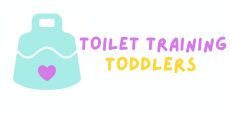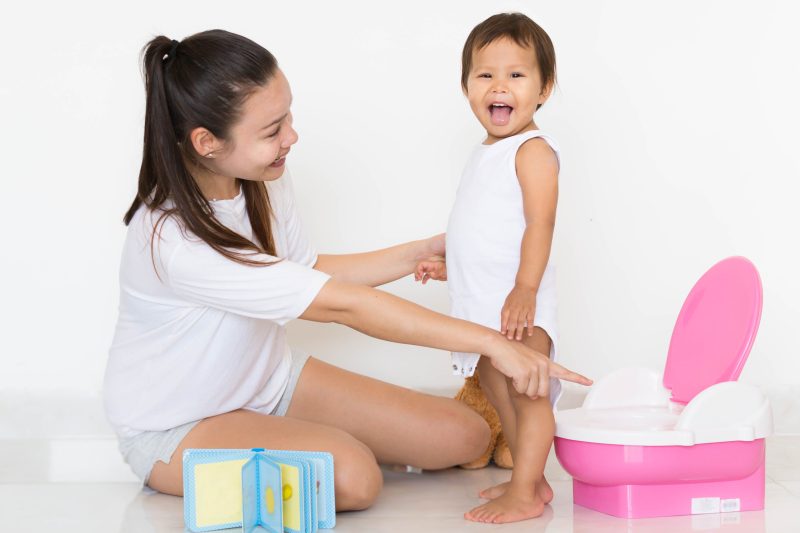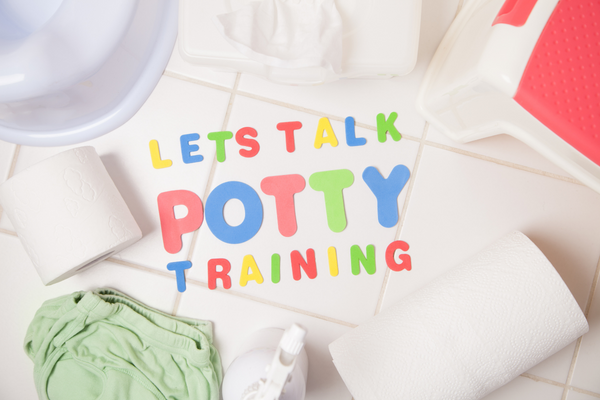Are you ready to dive into the world of potty training with a Montessori twist? It’s an exciting (and sometimes challenging) adventure for both you and your little one. But don’t worry, by developing an understanding of Montessori parenting principles and how they can support your and your little one through the potty training journey, you’ll be helping your child grow more independent and confident throughout the process.
Let’s start by chatting about the Montessori philosophy and its key principles. Then we’ll explore how to apply these ideas to potty training. You got this, mama!
A Quick Intro to the Montessori approach
Dr. Maria Montessori, an Italian physician and educator, created the Montessori philosophy in the early 20th century. This child-centered approach is all about nurturing a love of learning and independence in kids. Here’s a rundown of the most important Montessori principles:
Respect for the child
Montessori is all about treating each child as a unique individual. This means observing, understanding, and respecting their interests, needs, and abilities.
The prepared environment
Montessori spaces are designed to be orderly and purposeful. They’re filled with a variety of materials and activities, arranged in a way that invites self-directed exploration and learning.
The role of the teacher
Montessori teachers (aka guides) are more like supportive friends than strict instructors. They carefully observe each child, offering personalized guidance and support, while letting the children take charge of their own learning.
The absorbent mind
The Montessori method knows that young kids are total sponges when it comes to learning. They soak up info from their surroundings and develop skills super quickly, so Montessori helps harness their natural curiosity.
Sensitive periods
Montessori recognizes that children have specific times when they’re especially ready to learn certain skills or concepts. The curriculum is tailored to make the most of these golden moments, offering just the right activities and materials.
Freedom within limits
In a Montessori classroom, kids can explore and learn at their own pace, but they also have clear boundaries and expectations to follow.
Mixed-age groupings
Montessori classrooms usually have a mix of ages, which encourages peer-to-peer learning and collaboration. This setup helps develop social skills, empathy, and a sense of community.
Hands-on learning
Montessori materials are designed to be super engaging and tactile. They encourage kids to learn through hands-on experiences and playing with objects.
Independence and self-discipline
Montessori aims to nurture independent, self-disciplined kids by giving them choices, letting them learn from mistakes, and encouraging them to take responsibility for their own learning.
Follow the child
The Montessori method highlights the importance of observing and following each child’s interests and needs. This way, we can offer personalized guidance and support to help them shine.
Now that we’ve covered the fundamentals of Montessori parenting, let’s see how to apply these principles to your child’s potty training adventure!
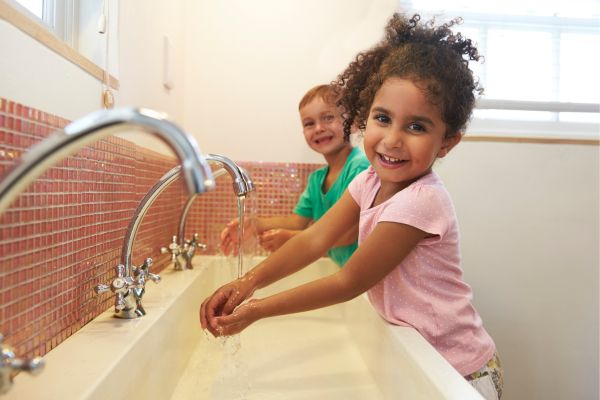
Respect for the child: Remember, every child is unique and ready for potty training at different times. Watch for their cues and readiness, and don’t rush them before they’re ready.
The prepared environment: Set up a potty training space that’s accessible, comfy, and inviting. Make sure the potty is the right size and height, and use a step stool if needed. Keep the bathroom clean, well-lit, and stocked with all the essentials. I’ll touch on this in more detail.
The role of the teacher: In this context, the teacher is the partner or caregiver. It’s your role to be their cheerleader during potty training. Offer gentle reminders, encouragement, and help when needed, but let your child take the lead.
The absorbent mind: Kids are naturally curious and eager to learn. Use this to get them interested in potty training. Explain the process, read fun books about it, and show them how it’s done.
Sensitive periods: Keep in mind that the potty training window usually happens between 18 months and 3 years old. But each child is different, so be patient and look for signs of readiness, like showing interest in the potty, staying dry longer, or disliking dirty diapers. We’ll dive further into harnessing the sensitive period later on.
Freedom within limits: Give your child choices and control during potty training, like picking their own undies or deciding when to use the potty. Set clear expectations and boundaries, but let them learn at their own pace.
Mixed-age groupings: If you have older kids or know other families, let your child observe and learn from their potty-trained peers. This can be super motivating and give them a role model to follow.
Hands-on learning: Get your child actively involved in potty training, like pulling down their pants, emptying the potty, and washing their hands. This hands-on approach can boost confidence and independence.
Independence and self-discipline: Encourage independence by letting your child take charge of their potty training. This means recognizing when they need to go, undressing themselves, and cleaning up afterward.
Follow the child: Keep an eye on your child’s progress and adjust your approach as needed. Some kids might need more support and encouragement, while others might want more independence. Be patient, flexible, and responsive to your child’s unique needs and personality during the potty training process.
The Potty Training Journey: Let’s Break It Down
In the first stage of potty training (preparation and readiness), the key is to watch your child for signs of readiness and introduce potty training in a gentle, no-pressure way.
Create a cozy and inviting potty space to encourage your little one to explore and get comfy with the potty in a relaxed environment.
Keep an eye on your child’s cues, both physical and emotional, to figure out the perfect time to start potty training.
Next up, the introduction and routine stage! Focus on encouraging independence by dressing your little one in easy-to-remove clothes and teaching them essential self-care skills. A consistent potty schedule and routine helps your child feel more in control and know what to expect.
Reaffirm your child’s efforts to boost their motivation and self-confidence.
When your child reaches the mastery and maintenance stage, they’ve gotten pretty good at potty training and are now working on keeping up their new skills.
During this stage, keep encouraging independence and reinforcing established routines and self-care skills.
Your support will help your child feel accomplished and confident in their newfound abilities. Keep an eye out for any setbacks or regressions, and offer extra support and guidance when needed while staying positive and patient.
Finally, during the transition and completion stage, your child is ready to move from potty training to full independence in their bathroom routine.
Encourage your little one to take full ownership of their toileting needs, which will help them develop a strong sense of self-confidence and accomplishment.
Gradually phase out any remaining support or guidance, letting your child rely on their own skills and judgment. You did it!
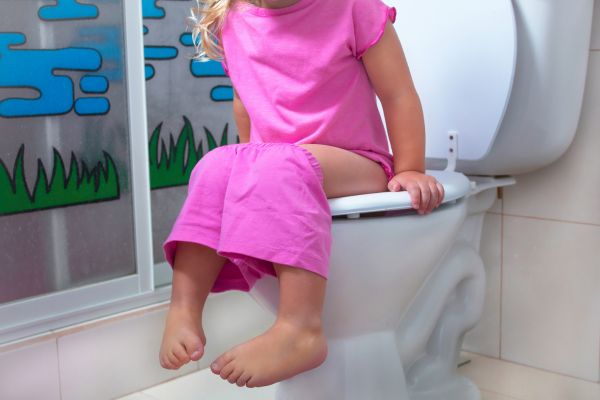
How to Set Up a Potty Training Haven (aka prepared environment)
Creating a potty training haven for your toddler means setting up a space that’s accessible, comfy, and encourages independence.
Here are some tips to help you create the perfect potty training environment:
Choose the right potty
Pick a potty chair or seat that’s just right for your little one. It should be stable and comfy to sit on. Some kids like a separate potty chair, while others prefer a toilet seat adapter on the big toilet.
Make it easy to reach
Put the potty somewhere convenient and easy for your child to access, preferably in the bathroom. If you have a two-story home, think about having a potty on each level to minimize accidents.
Provide a step stool
If your child uses a toilet seat adapter on the regular toilet, give them a step stool so they can reach the toilet safely and comfortably.
Keep supplies handy
Stock the bathroom with essentials like toilet paper, flushable wipes, a small trash bin, and extra clothes for accidents. Make sure these items are within your child’s reach to promote independence.
Make it fun and inviting
Jazz up the bathroom or potty area with colorful decorations, cool potty training charts, or even their favorite stuffed animal to make it more appealing.
Teach good hygiene
Set up a handwashing station with a step stool, soap, and hand towels within your child’s reach. This helps build good habits from the get-go.
Give them privacy
If possible, give your child some privacy while they’re using the toilet. You can use a privacy screen, curtain, or just give them some space when they’re on the potty.
Light it up
Make sure the bathroom or potty area is well-lit so your child feels comfy and safe when using the toilet.
Stick to a routine
Create a consistent potty break routine, like going to the bathroom when waking up, before meals, and before bedtime. This helps your child know what to expect and adds structure to the process.
Dress for success
Choose clothes that are easy to remove and put on to help your child feel independent during potty training. Go for pants with elastic waistbands or loose dresses they can easily pull up and down. Avoid tricky fastenings like buttons, snaps, or zippers. Choose soft, comfy fabrics and let your child pick their underwear, making them excited about the transition from diapers.
Remember, patience and flexibility are key. Keep an eye on your child and adjust the environment as needed to support their unique needs and preferences during potty training. You got this!
How to approach setbacks and accidents
Managing setbacks and accidents during the potty training process is an essential aspect of the journey. It’s crucial to approach these situations with patience, understanding, and strategies aligned with Montessori principles. This way, you can support your child’s individual needs and help them overcome challenges while maintaining a positive potty training experience.
There are a few common challenges that you might encounter during potty training, and here are some Montessori-based solutions to help you address them:
Resistance to potty training
If your child is resistant to potty training or seems disinterested, it’s important to respect their feelings and not force the issue.
Montessori tip: You can observe your child to identify any underlying causes, like fear or discomfort, and offer gentle guidance and reassurance. If needed, you can temporarily pause the process and give your child time to become more comfortable with the idea of potty training.
Accidents
When accidents happen, it’s crucial to stay patient and understanding. Keep calm and avoid negative reactions or punishment.
Montessori tip: Encourage your child to help clean up the mess, which will foster responsibility and independence. Use the accident as a learning opportunity by discussing what happened and exploring ways to prevent similar situations in the future. Focus on your child’s efforts and progress, praising them for their achievements rather than dwelling on setbacks.
Regression
If your child experiences regression during potty training, remember that it’s a normal part of learning and development.
Montessori tip: Be patient and understanding, and consider any external factors that might contribute to the regression, such as stress, illness, or changes in routine. Affirm positive behaviors and routines by providing additional support and encouragement as needed. Celebrate your child’s successes, both big and small, to boost their self-confidence and motivation.
Fear or anxiety
Some children may feel anxious or fearful about potty training, like being scared of the toilet or experiencing unfamiliar sensations.
Montessori tip: Encourage open communication so your child can express their feelings and concerns. Offer reassurance and support, ensuring they feel safe and secure during the process. Gradually introduce the potty, creating a comfortable and inviting space for your child to explore at their own pace. Model a positive attitude and offer praise for their efforts, which will help them build confidence and overcome their fears.
Remember that every child’s potty training journey is unique, so it’s essential to be patient, flexible, and supportive. By using Montessori principles and focusing on your child’s individual needs, you can help them navigate setbacks and accidents while maintaining a positive and encouraging environment.
Embrace the fact that setbacks are a natural part of growth and development. They offer valuable learning opportunities for both you and your child. By approaching these challenges with understanding and empathy, you can foster a strong sense of self-confidence and resilience in your child, setting the foundation for future success and independence in all aspects of their life.
The Bottom Line
Potty training is a significant event in your child’s development, and applying Montessori principles can help create a positive and effective experience for both you and your little one.
By emphasizing independence, self-confidence, and a sense of achievement, you’ll pave the way for a successful shift from diapers to complete toileting autonomy. Patience, understanding, and support are essential throughout the process, as setbacks and accidents are normal aspects of learning and development. Collaborating with your child and celebrating their progress at each stage will contribute to building a strong foundation for lasting independence and self-assurance.

Note From The Author: Laura at Montessori Tips
I first stumbled upon the Montessori method while helping a friend choose open-shelving ideas for her toddler’s play area – I’m a visual designer and interiors enthusiast so she was seeking my input. When I became a parent myself, I instantly became fascinated with the Montessori principles and found that they aligned closely with my own personal values. I delved deeper into its practical applications in daily life, discovering effective ways to foster independence and self-confidence in children.
Through Montessori Tips I’m passionate about sharing Montessori-inspired ideas and strategies with other parents to help them navigate important milestones like the potty training journey. My goal is to empower both children and parents, creating a solid foundation for lifelong independence and confidence.
Feel free to visit me and learn more about my Montessori Tips.
.
